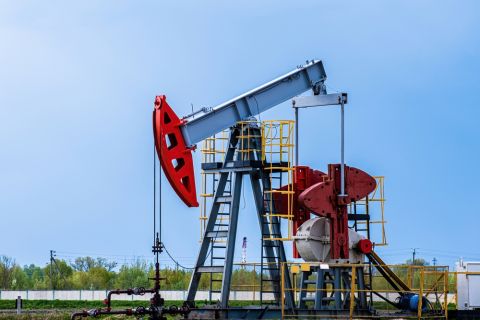The global oil and gas industry has put more hydrocarbon resources onstream than it has discovered since the early 1980s, and the trend is getting more serious. That's normally a signal that would push prices higher, but that pressure will be a long time coming in oil and gas. The world still offers plenty of oil and gas resources, and supply will continue to outstrip demand, said Pete Stark, vice president of industry relations with IHS Energy. The global energy information firm hosted an international topics forum at NAPE 2004 in Houston. Countries producing more than 50 million barrels of oil per day will add 10.1 million barrels of daily supply capacity between 2003 and 2007, while daily demand climbs only 6.5 million barrels, he said. In that scenario, OPEC will attempt to control prices, but the production gains will come from both OPEC and non-OPEC countries. That's what makes price controls more difficult. Production from Iraq will play a key role in price fluctuation, he said, and Venezuela, Algeria and Nigeria will continue to pressure OPEC for higher production quotas. They will push the equation toward higher production levels. Meanwhile, if present trends continue, countries will become increasingly competitive to get a piece of the $3 trillion dollars of investment needed in the industry through 2030, Stark said, and nations will continue to seek an optimal balance of risk and reward for oil and gas operations. That competition should result in more favorable terms for operators in the international arena. On the bottom line, the world will have excess oil with weak and volatile prices through the remainder of this decade. That prognostication hasn't changed much. The dollars will flow to the resources-the Middle East and Russia-and low-cost producers will be the winners. Operators will continue to register new discoveries, many of them large, but if present trends continue, they won't match resources put into production. Between year-end 1999 and July 1, 2003, operators recorded 73.4 million barrels of oil equivalent (BOE) in discoveries. Kazakhstan led the world with nearly 14 billion BOE, thanks to the Kashagan Field in the northern Caspian Sea. China and Australia followed, while the U.S. Gulf of Mexico landed in ninth spot, ahead of Russia, but behind Iran. No matter how massive the discoveries, the number of onshore discoveries with 100 million BOE or more peaked in 1988, and the number of offshore discoveries with the same volume peaked in 2002, Stark said. The world has some 11,785 trillion cubic feet (Tcf) of gas but the distribution of production is uneven. North America has used more than half of its recoverable gas and had less than 200 Tcf remaining at the end of 2002. That compares with the former Soviet Union with nearly 2,000 Tcf and the Middle East with close to 2,600 Tcf remaining. Russia has used only 16.2% of its gas and the Middle East still has 95.1% left, Stark said.
Recommended Reading
Post Oak-backed Quantent Closes Haynesville Deal in North Louisiana
2024-09-09 - Quantent Energy Partners’ initial Haynesville Shale acquisition comes as Post Oak Energy Capital closes an equity commitment for the E&P.
Private Producers Find Dry Powder to Reload
2024-09-04 - An E&P consolidation trend took out many of the biggest private producers inside of two years, but banks, private equity and other lenders are ready to fund a new crop of self-starters in oil and gas.
Companies Take Advantage of ABSs to Finance Acquisitions
2024-10-17 - Some companies have taken advantage of asset-backed securitizations to monetize some of their cash flows and better position themselves for a sale.
Private Equity Gears Up for Big Opportunities
2024-10-04 - The private equity sector is having a moment in the upstream space.
Post Oak Backs New Permian Team, But PE Faces Uphill Fundraising Battle
2024-10-11 - As private equity begins the process of recycling inventory, likely to be divested from large-scale mergers, executives acknowledged that raising funds has become increasingly difficult.
Comments
Add new comment
This conversation is moderated according to Hart Energy community rules. Please read the rules before joining the discussion. If you’re experiencing any technical problems, please contact our customer care team.





